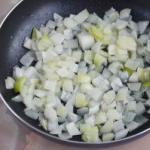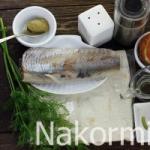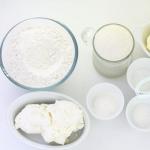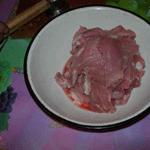Daifuku with strawberries recipe. Japanese cuisine: Mochi - healthy sweets made from rice. Mochi with ice cream inside
Mochi is a rice cake that is traditionally eaten on holidays, especially New Year's. "Daifuku mochi" can be translated as "rice cake for great luck."

Daifuku Mochi: Japanese sweets

The process of making classic mochi is called “mochi-tski”. You can see what it looks like in the video: cooked rice is kneaded in a mortar, hitting it with a wooden hammer, mixing the dough between blows.

Daifuku Mochi: Japanese sweets

In the West, mochi are usually perceived as sweets, but in Japan, these rice cakes can even be found in soup. Historically, they came to Japan from China quite a long time ago (they were mentioned in Japanese literature of the 8th century), but they did not immediately become a mass dish: initially they were made only on special occasions, for special people of the upper classes. Gradually, “mochi” seeped into the lower strata of the population, because it is tasty, does not spoil for a long time, and is relatively easy to prepare.
The current "mochi" in Japan is one of the varieties of "wagashi", traditional sweets served with tea. Typically, wagashi is made exclusively by master pastry chefs, using techniques that have been passed down from generation to generation for many centuries. It is believed that making wagashi at home is a bad idea due to the complexity of the process, and this applies to any type of wagashi, except, perhaps, mochi pies.
The most common type is “daifuku mochi”: a rice flour ball with a filling inside. The filling can be anything: azuki bean paste (called anko), various fruits, berries (ichigo daifuku), and even ice cream.
Daifuku Mochi Recipe
So, let's move directly to the process. Making mochi yourself is very simple, and to prepare daifuku mochi we will need the following ingredients:
300 grams (2 cups) glutinous rice flour (called Mochiko in Japan).
350 grams (1½ cups) water.
150 grams (¾ cup) sugar.
1 teaspoon (¾ volume) of vanillin.
2.5 tablespoons corn syrup.
You will need a little potato starch to ensure that our dough does not stick anywhere.
You also need to think about the filling in advance, be it traditional azuki bean paste (250 grams, found in jars in Asian stores), or something else to your taste.
You can make gluten rice flour yourself by simply finely grinding the corresponding rice, fortunately you don’t need that much of it. Corn syrup - can be purchased at the store. Here it acts as a thickener and sweetener.
Step one: To prepare the dough, you can use either a gas stove or a microwave oven. Leave the mortar and hammer for later. Choose any of the options:
For the microwave - mix all ingredients (except starch and filling) in a glass container suitable for heating. Cover the dishes (preferably with cling film) and expose them to microwaves at the maximum available power for about 2 minutes. After the set time has passed, mix the substance and put it in the microwave for another 4 minutes.
For a gas stove, pour water into a medium-sized saucepan, let it boil, and leave it on “medium heat.” Add sugar, vanillin and corn syrup to the water, stirring until they are completely dissolved. Add flour in small portions, stirring constantly: you need to achieve a homogeneous consistency. Once the result is achieved, remove from heat.
Step two: Pour the resulting mass onto a table or board surface previously sprinkled with starch. We don’t skimp on starch, because if it sticks to the table, we’ll have to eat it along with the table. Joke. 🙂
The dough must be divided into 20 equal pieces, each of which must subsequently be rolled out to a flat pancake. The filling you choose is placed on the pancake, the pancake is closed like a bag by “pinching”.
Step three: It is advisable to lightly roll the finished product in starch so that it does not stick to your fingers, and then turn it over (so that the place where the ball is “closed” is at the bottom) onto a plate flavored with the same starch.
If you decide to give your “mochi” some shape, make a figured pattern on them by pressing - know that this procedure is best performed immediately before serving. Depending on the consistency of your dough - sooner or later, under the influence of gravity - the balls will want to spread out on the plate - whether you want it or not.
You can make mochi with ice cream inside. Just put a teaspoon of ice cream inside and immediately put the product in the freezer for a couple of hours. The product must be removed from the freezer a few minutes before serving. Also, do not forget to supply all surfaces with starch, otherwise the “mochi” will have to be eaten along with the surfaces on which they lie.
Good day, colleagues and readers! Today I invite you to get acquainted with Japanese cuisine, or rather with the most common type of sweet dessert in Japan (and in many eastern countries) called “Daifuku Mochi” and, accordingly, prepare it yourself using the necessary products, of which there are not many here and my explanations and explanations. The dish turns out magnificent, festively colorful and delicate in its characteristics, and its taste will pleasantly surprise you.
So, how to prepare this dessert?
We will need these ingredients, the exact quantities of which you will find at the top of this recipe. Naturally, you can choose the fillings yourself according to your taste and based on your taste preferences.

1. First, first of all, you and I take Anko paste (you can see how to prepare it in my recipe Anko bean paste - Sweet Japanese bean paste with an unusual taste... Minimum ingredients, maximum ease of preparation) and cleared of foreign matter green berries. We separate the grapes and free them from the branches, remove the green leaves from the strawberries, and generally peel the kiwi using a knife. Flatten the Anko paste with your hands into a flat cake (rolling it out with a rolling pin is unlikely to work - it is quite sticky, so they sprinkle it with starch). Place the prepared berries on top.

2. And wrap them in Anko paste. Fortunately, this paste is very plastic and pliable and it is a pleasure to work with it - like with children's plasticine. Just try not to forget, but somehow note for yourself where your figures (more precisely, the berries) are top and bottom - this way you will make your Daifuku more beautiful when you cut it. If, of course, you are preparing them for yourself, then you don’t have to cut them and you don’t have to remember or mark the position of the berries in space.

3. Now, after you have finished wrapping the berries in Anko paste, cover them with a plastic bag or lid so that they do not dry out and you can prepare the sweet rice dough Mochi. You can read how it is prepared in my recipe here Mochi dessert - sweet rice dough. Adapted recipe. We place the finished Mochi dough on the starch, since it is very sticky and sticks to everything it can, and sprinkle it on top with the same starch.

4. Distribute the dough evenly and thinly over the surface of the dish, generously sprinkled with starch, with your fingers, constantly sprinkling them with starch (naturally, after the dough has cooled slightly and you can work with it with your bare hands) and divide it into several equal parts of the size you need will be needed to wrap berries with Anko paste in them.

5, Wrap the prepared balls with Anko bean paste in Mochi dough. Rice dough is as flexible and molds well as this paste, so don’t worry - everything will work out easily.

That's all - our dessert from Japan, China and other neighboring countries is completely ready and you can already taste it and taste its unusual, but at the same time pleasant and delicate taste, combining in its bouquet such a variety of tastes as the light taste of sweet beans, the taste of sweet rice and the flavors and juiciness of the various berries you used in this dessert. I am sure that you will not only be pleasantly surprised by this dessert, but also pleased with its unusual taste.

Well, according to tradition, I wish you bon appetit and creative culinary success!
Cooking time: PT00H20M 20 min.
This delicious Japanese dessert is prepared like this:
1. Fresh wormwood leaves are washed.
2. Boil water in a small saucepan. Add wormwood and boil for 1-2 minutes. Allow the leaves to cool.
3. Meanwhile, prepare the anko bean paste and place the balls of it on the foil. You need to prepare 12 balls. For this:
- the beans are washed and placed in a pan;
- pour water to the top of the beans and bring to a boil;
- then reduce the heat, cover the pan with a lid and cook for an hour until the beans become soft;
- when the water evaporates, add more water - the beans should always be covered with water;
- pour the broth from the finished beans into a separate bowl;
- a small handful of beans is set aside, the rest of the beans are crushed and rubbed through a sieve;
- add sugar and set aside whole beans to the bean puree, mix thoroughly;
- cook the resulting mass in a saucepan over low heat for 10-15 minutes until it acquires a dark brown or maroon color;
- when the bean mass becomes too thick during cooking, add the decoction left after the previous cooking;
- the finished anko paste is left to cool.
4. Beat the wormwood leaves along with 3/4 of the decoction with a blender until smooth.
5. Strain the mixture from the blender through a sieve into a measuring cup. Add the required portion of the remaining broth to the cup up to the 150 ml mark.
6. In a large microwave-safe bowl, combine rice flour, 200 grams of sugar, salt and rice vinegar. Add 150 ml of wormwood decoction prepared earlier and beat with a whisk until a homogeneous dough is obtained.
7. Cook the dough mochi in the microwave for 8-10 minutes on high power.
8. Mix together potato starch and 40 grams of sugar. Sprinkle some of this mixture onto the cutting board and carefully remove the hot mass - mochi - from the microwave. Sprinkle a mixture of starch and sugar on top.
9. Using the flat edge of a large knife, straighten the mochi from above and straighten the edges to form a rectangular layer.
10. Cut the mochi into 12 pieces.
11. Roll out each part and place the filling in the center - a ball of red bean paste. Lift the edges of the mochi up and press them tightly, sprinkle the sealed edges with a mixture of starch and sugar. Turn the ball over and place it on a cutting board sprinkled with a mixture of starch and sugar.
12. The finished wrapped mochi with filling is coated with soy flour.
13. Serve immediately warm or store mochi in the refrigerator until serving, covered with plastic wrap. This dessert can be stored for 2-3 days.
14. Yomogi Daifuku from the refrigerator is heated in the microwave until soft before use.
Bon appetit!
Daifuku is a type of Japanese sweet confection. It is a small pastry made from glutinous rice paste and filled with a sweet filling. Sometimes it is also called mochi. In general, “Daifuku” is a shortened word for “Daifukumochi” (daifukumochi), which means “big white cake of luck.”

In Japan, they believe that this cake really brings good luck, so it is a traditional gift in this country (including for the New Year).
Most daifuku recipes call for mixing rice flour and water, then heating the mixture in the microwave. The result is a thick sticky dough, which is rolled out while hot and formed into a thin layer. After this, the dough is cut into rectangles. Each rectangle will then become a separate daifuku.
The chef takes each rectangle and wraps it around the filling, then sprinkles it with flour or sugar. After baking, the dough is cooled and it hardens slightly.
Making brownies using a microwave or steamer is quite simple. If you prepare them in the traditional way, it will take much longer, since it all represents a certain type of ritual. First, cooks soak the rice in water for several hours, often overnight, after which they steam it and then grind it into a paste using a mortar.
The resulting paste is then formed into round or square cakes. Daifuku cake is a Japanese traditional New Year's dish. The most common filling for daifuku is a paste of red azuki beans and sugar or honey. True, there are other filling options, consisting of strawberries, pieces of fruit or melon paste.
Adding a variety of colors to daifuku makes the cake colorful. It can be pink or even green. Some natural colors, such as wormwood, can give cakes a distinctive flavor. One type of daifuku, yukimi daifuku, uses ice cream as a filling.
A scoop of ice cream is usually wrapped in rice dough. This cake remains soft even if it has just been taken out of the refrigerator.

Source:
________________________________________ __
2. Japanese mochi recipe
When I returned home from Japan, I really missed this country. And so I immediately took up culinary experiments. After all, it is the cuisine that conveys the character of the people, their customs and mood.
Through trial and error, I managed to get the perfect mochi recipe. The sweetness prepared using it is in no way inferior to its Japanese counterpart. This recipe also includes ingredients that are accessible to everyone!

Ingredients:
50 g corn starch
250 g glutinous rice flour (a special type of rice, sold in Russia on the Internet, moderators)
300 g adzuki beans
Salt 15 g
Sugar 3 cups
Water 4 tsp.
Matcha Green Tea Powder
Cooking method
Adzuki beans must be boiled with 100 g of sugar for 45 minutes. This will take 2 cups of water. Afterwards, cool the beans and blend them to a paste using a blender.
In a ceramic saucepan, separately mix the remaining sugar with salt, matcha tea and glutinous rice flour with 1 cup of water. Mix thoroughly until a homogeneous mass is obtained.
Afterwards, the saucepan is tightly packed with cling film and placed in the microwave for 3 minutes at maximum heat. The Japanese recipe calls for a homogeneous and viscous mochi dough. If you get this consistency, leave it aside to cool. If not, place in the microwave for another minute.
While the glutinous rice flour dough is cooling, form the bean paste into balls.
Knead the cooled dough thoroughly. After all, thoroughly kneaded dough is the main secret of delicious mochi. Moreover, the Japanese even hit it with a rolling pin for 4 minutes to get the required consistency.
The dough is ready, which means it's time to prepare the place for modeling. I sprinkle the table with starch. You shouldn’t forget about your hands either, this way the dough won’t stick. Then roll out the sausage and cut it into 8 equal parts.
Since glutinous rice flour dough dries quickly, wrap all parts in cling film.
Take one of the pieces of dough and knead it into a thin round cake. Place the bean paste filling inside and wrap it up.
We repeat this procedure with the remaining pieces. If you do not add powdered tea, the Japanese dessert mochi will look light (photo at the end of the recipe).
This sweet is usually served with green tea. Although I have tried them with coffee too. And I can say that it is very tasty!













